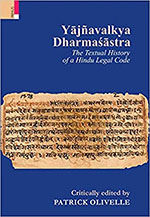Patrick Olivelle is amongst those to whom scholars of ancient Indian history, Sanskrit and others interested in early textual traditions are indebted, as he has, for decades, tirelessly and painstakingly provided access to a wide variety of texts. This volume represents yet another contribution, a typically generous act of scholarship that we have now begun to almost take for granted.
The Yājñavalkya Dharmaśāstra, as Olivelle reminds us in his magisterial introduction, was significant throughout the early medieval period and later. At the same time, there were real and notional antecedents. Olivelle maps the textual genealogies within which this particular sastra was embedded. He draws attention to passages connecting the attributed author with Sage Yajnavalkya, a central figure in the later Vedic Satapatha Brahmana. Further, the text is located within sastric and Puranic traditions. Olivelle compares the text with the Manava Dharmasastra, even as he alerts us to the different logics that underlie the ordering of the content in each text, as well as their stylistic differences. In terms of content, there are parallels with both the Manava Dharmasastra and the Arthasastra in particular, as well as with a range of other texts. Olivelle demonstrates how the reliance on the two classical sastras is useful for the editor attempting to reconstruct the critical edition. At the same time, he points out how textual parallels amongst all three sastras coexist with the occasional use of a distinct vocabulary. He also discusses how, in some instances, a lack of familiarity with the original text led to changes within the manuscript tradition. For example, the category of the dravya vana—the forest that yields produce that was considered valuable by the state—was routinely used in the Arthasastra. However, the later tradition was no longer familiar with the term, and replaced dravya with grama or village (Chapter 2, verse 286, p. 277). These interventions alert us to the need for a contextual reading of the texts and commentaries. As Olivelle both acknowledges and elucidates these changes carefully, he forecloses any possibility of understanding the tradition as monochromatic or monolithic.

